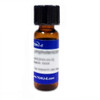2’-C-Methylcytidine (syn: 2CMC) is a viral replication inhibitor, shown to be active against multiple viruses including hepatitis C virus (HCV), inhibiting the HCV NS5B RNA polymerase. It is also used against other viruses including Norwalk, West Nile, dengue, foot-and-mouth, and yellow fever. The compound is a ribonucleoside analog and acts as a bioactive small molecule inhibitor of viral nucleoside polymerase.
2’-C-Methylcytidine is sparingly soluble in water.
| Application | 2’-C-Methylcytidine is useful for the development of antiviral research compounds. |
| Mechanism of Action | 2’-C-Methylcytidine has been shown to be a small-molecule inhibitor of viral nucleoside polymerase. In hepatitis C virus, it inhibits HCV NS5B RNA polymerase.
In studies with foot-and-mouth disease, experiments suggest that the compound interacts with the viral replication that coincides with the onset of intracellular viral RNA synthesis. |
| Spectrum | 2’-C-Methylcytidine can be used for multiple viruses including hepatitis C virus (HCV), Norwalk virus, and bovine pestivirus. It is also effective for three flaviviruses including yellow fever virus, West Nile virus, and dengue-2 virus. It has in vitro activity against coxsackievirus causing hand-foot-and-mouth disease and yellow fever virus. |
| Microbiology Applications | NM 283 is an efficient prodrug of 2’-C-methylcytidine. It is an 3’-O-L-valinyl ester derivative. It is a promising antiviral for HCV infection (Pierra et al, 2011).
Studies in a cell-based replicon assay indicated that several of the phosphoaramidates including NM 283 demonstrated a 10- to 200-fold potency due to higher levels of 2’-C-methylcytidine triphosphate in the cells. These prodrugs are converted to the triphosphate in hepatocytes (Gardelli et al, 2009). |
| Molecular Formula | C10H15N3O5 |
| References |
Gardelli et al (2009) Phosphoramidate prodrugs of 2’-C-Methylcytidine for therapy of Hepatitis C virus infection. J. Med. Chem. 52(17):5394-5407 PMID 19725579 Julander JG et al (2010) Efficacy of 2’-C-Methylcytidine against yellow fever virus in cell culture and in a hamster model. Antivir. Res. 86(3):261-267 PMID 20227442 Nesya G et al (2007) 2’-C-Methylcytidine as a potent and selective inhibitor of the replication of foot-and-mouth disease virus. Antiviral Res. 73(3):161-168 PMID 17055073 Lee J et al (2015) Characterization of the activity of 2’-C-Methylcytidine against dengue virus replication. Antiviral Res. 116:1-9 PMID 25614455 Pierra et al (2006) Synthesis and pharmacokinetics of Valopicitabine (NM283), an efficient prodrug of the potent anti-HCV agent 2'-C-Methylcytidine. J. Med. Chem. 49(22):6614-6620 PMID 17064080 Pierra C et al (2011) NM 283, An efficient prodrug of the potent anti-HCV agent 2’-C-Methylcytidine. Nucleosides, Nucleotides and Nucl. Acids 24(5-7):767-770 Rocha-Pereira JD et al (2013) The viral polymerase inhibitor 2'-C-Methylcytidine inhibits Norwalk virus replication and protects against Norovirus-induced diarrhea and mortality in a mouse model. J. Virol. 87(21):11798-1805 PMID 23986582 |







